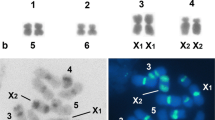Abstract
The Acrididae are frequently quoted as one of the classic examples of karyotypic stability. Within the family, the Cryptosacci, for instance, are characterised by a majority of species having 23 chromosome arms in the male. The members are then related by Robertsonian sequences in which the basic karyotype is believed to consist of 23 acrocentric elements. Thus the 17-chromosome complement of male truxalines is argued to have been derived from the basic type by three successive centric fusions. Such an origin is at variance with the fact that the rod-shaped chromosomes in eight of the nine species utilised in this study turn out in fact to be telocentric. The scheme is also at variance with the finding that significant differences in DNA content exist both between species within the same chromosome group and between member species of the 17 and 23 groups. The concept of karyotypic stability is thus called to question and the relationship of karyotypes within the family must be considerably more complex than has formerly been supposed.
Similar content being viewed by others
References
Christensen, B.: Cytophotometric studies on the DNA content in diploid and polyploid Enchytraeidae (Oligochaeta). Chromosoma (Berl.) 18, 305–315 (1966).
Coleman, L.C.: Chromosome structure in the Acrididae with special reference to the X-chromosome. Genetics 28, 2–8 (1943).
Darlington, C.D.: Crossing-over and its mechanical relationships in Chorthippus and Stauroderus. J. Genet. 33, 465–500 (1963).
—, and L.F. La Cour: Hybridity selection in Campanula. Heredity 4, 217–248 (1950).
Hughes-Schrader, S.: The nuclear content of deoxyribonucleic acid and interspecific relationships in the mantid genus Liturgousa. Chromosoma (Berl.) 5, 544–554 (1953); - The DNA content of the nucleus as a tool in the cytotaxonomic study of insects. Proc. Xth. Int. Congr. Entomol. 1956, 2, 935–944 (1958).
John, B., and G.M. Hewitt: The B-chromosome system of Myrmeleotettix maculatus I. The mechanics. Chromosoma (Berl.) 16, 548–578 (1965).
—, and K.R. Lewis: Genetic speciation in the grasshopper Eyprepocnemis plorans. Chromosoma (Berl.) 16, 308–344 (1965).
Kayano, H., and K. Nakamura: Chiasma studies in structural hybrids V. Heterozygotes for a centric fusion and for a translocation in Acrida lata. Cytologia (Tokyo) 25, 476–480 (1960).
Keyl, H.-G.: A demonstrable local and geometric increase in the chromosomal DNA of Chironomus. Experienta (Basel) 21, 191 (1965).
Lewitsky, G.A.: The morphology of the chromosomes. Bull. appl. Bot. 27, 19–173 1931).
Lima-de-Faria, A.: The role of the kintetochore in chromosome organisation. Hereditas (Lund) 42, 85–160 (1956).
Makino, S., and E. Momma: Observations on the structure of grasshopper chromosomes subjected to a new acetocarmine treatment. J. Morph. 86, 229–252 (1950).
Marks, G.E.: The cytology of Oxalis dispar (Brown). Chromosoma (Berl.) 8, 650–670 (1957); - Telocentric chromosomes. Amer. Naturalist 91, 223–232 (1957).
Matthey, R.: Polymorphisme chromosomique intraspécifique et intraindividuel chez Acomys minous Bate (Mammalia-Rodentia-Muridae). Étude cytologiques des hybrides Acomys minous ♂ × Acomys cahirinus ♀. Le méchanisme des fusions centriques. Chromosoma (Berl.) 14, 468–497 (1963).
McClung, C.E.: A comparative study of the chromosomes in orthopteran spermatogenesis. J. Morph. 25, 651–749 (1914).
McLeish, J., and N. Sunderland: Measurements of deoxyribosenucleic acid (DNA) in higher plants by Feulgen photometry and chemical methods. Exp. Cell Res. 24, 527–540 (1961).
Morrison, J.W.: Chromosome interchange by misdivision in Triticum. Canad. J. Bot. 32, 281–284 (1954).
Muller, H.J.: Bearings of the ‘Drosophila’ work on systematics, p. 185–268 in: The new systematics. Oxford: Clarendon Press 1940.
Nawaschin, S.: Sur quelques charactères de l'organisation interne des chromosomes, p. 185–214. Réc. d'Art Sci. dédié à C. Timiriaseff. Moscow 1916.
Rhoades, M.M.: Studies of a telocentric chromosome in maize with reference to the stability of its centromere. Genetics 25, 483–520 (1940).
Schrader, F., and S. Hughes-Schrader: Polyploidy and fragmentation in the chromosomal evolution of various species of Thyanta (Hemiptera). Chromosoma (Berl.) 7, 469–496 (1956); - Chromatid autonomy in Banasa (Hemiptera: Pentatomidae). Chromosoma (Berl.) 9, 193–215 (1958).
Sunderland, N., and J. McLeish: Nucleic acid content and concentration in root cells of higher plants. Exp. Cell Res. 24, 541–554 (1961).
Ullerich, F.-H.: Karyotyp und DNS-Gehalt von Bufo bufo, B. viridis, B. bufo × B. viridis und B. calamita (Amphibia, Anura). Chromosoma (Berl.) 18, 316–342 (1966).
Wahrman, J., and R. O'Brien: Nuclear content of DNA in chromosomal polymorphism in the genus Ameles (Orthoptera:Mantoidea). J. Morph. 99, 259–270 (1956).
White, M.J.D.: Cytogenetics of orthopterid insects. Advanc. Genet. 4, 267–330 (1951); - Some general problems of chromosomal evolution and speciation in animals. Surv. Biol. Progr. 3, 109–147 (1957); - Cytogenetics of the grasshopper Moraba scurra 1. Meiosis of interracial and interpopulation hybrids. Aust. J. Zool. 5, 285–304 (1957); - Chiasmatic and achiasmatic meiosis in african eumastacid grasshoppers. Chromosoma (Berl.) 16, 271–307 (1965).
—, H.L. Carson, and J. Cheney: Chromosomal races in the australian grasshopper Moraba viatica in a zone of geographic overlap. Evolution (Lawrence, Kansas) 18, 417–429 (1964).
Wolf, B.E.: Zur Karyologie der Eireifung und Furchung bei Cloeon dipterum L. (Bengtsson) (Ephemerida, Baetididae). Biol. Zbl. 79, 153–198 (1960).
Author information
Authors and Affiliations
Rights and permissions
About this article
Cite this article
John, B., Hewitt, G.M. Karyotype stability and DNA variability in the Acrididae. Chromosoma 20, 155–172 (1966). https://doi.org/10.1007/BF00335205
Received:
Issue Date:
DOI: https://doi.org/10.1007/BF00335205




